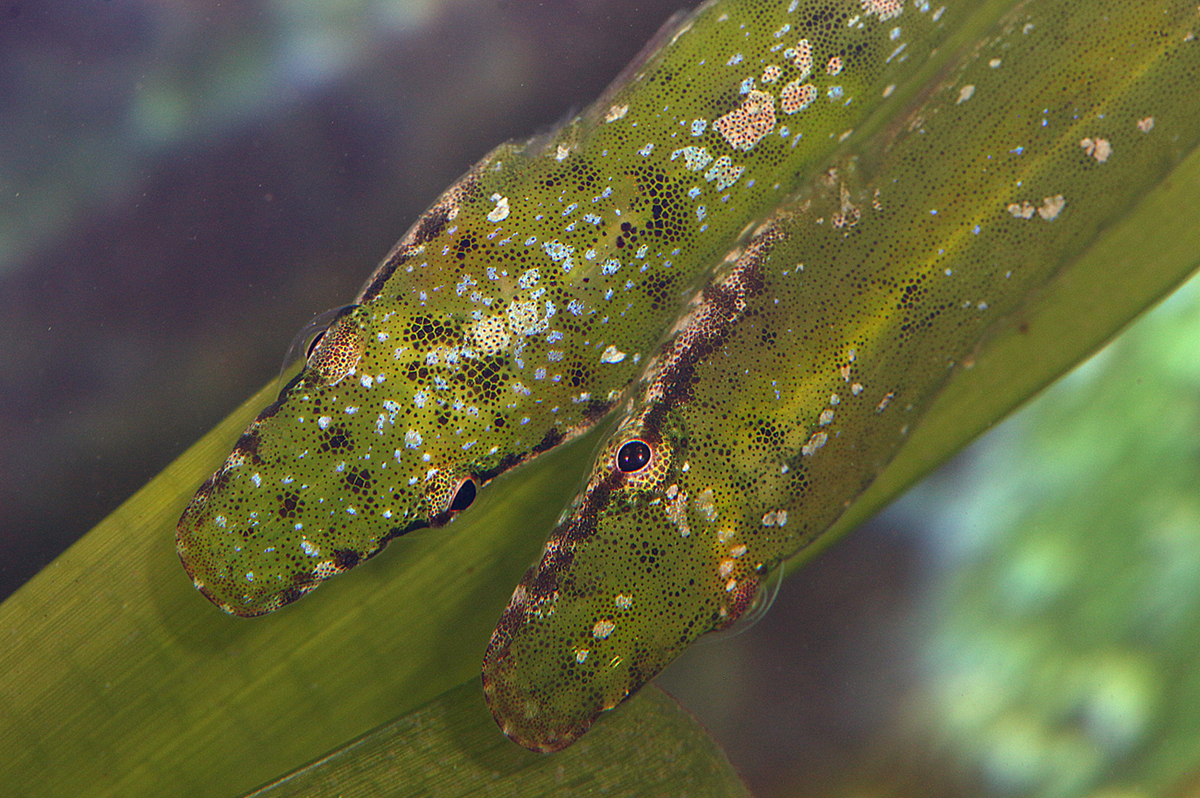Spadenose Clingfish, Cochleoceps spatula (Günther 1861)
Other Names: Spade-nose Clingfish

Spadenose Clingfish, Cochleoceps spatula, at Garden Island, Western Australia, May 2019. Source: Glen Whisson / iNaturalist.org. License: CC by Attribution-NonCommercial
Summary:
A small slender green to brownish clingfish covered in tiny close-packed brown spots, many forming short dark lines and blotches on the head and body, with six short dark brown bars across back and row of dark brown blotches along the midside. Larger individuals often have small white blotches, sometimes producing a piebald appearance.
The Spadenose Clingfish has a relatively long, depressed, rectangular-shaped snout (when seen from above), and the anterior and posterior nostrils positioned well before the eye.
The Spadenose Clingfish has a relatively long, depressed, rectangular-shaped snout (when seen from above), and the anterior and posterior nostrils positioned well before the eye.
Cite this page as:
Bray, D.J. 2022, Cochleoceps spatula in Fishes of Australia, accessed 17 Apr 2024, https://fishesofaustralia.net.au/Home/species/4133
Spadenose Clingfish, Cochleoceps spatula (Günther 1861)
More Info
|
Distribution |
Endemic to southern Australia from Port Gawler, South Australia, to Fremantle, Western Australia. Inhabits shallow, protected seagrass beds. |
|
Features |
Dorsal fin 4-7; Anal fin 6-8; Pectoral fin 17-20; Pelvic fin i, 4; Causal fin 10-12; Vertebrae (total) 34-35. Body elongate, subcylindrical, tapering to a moderately long, compressed caudal peduncle. Head of moderate breadth, flat; snout moderately long, spade-like; posterior nostril in advance of anterior margin of each eye; eyes of moderate size; lips narrow, fleshy; mouth small, reaching to below centre of eyes, jaws of equal length; teeth small, conical; no spines laterally on head; gill openings large, lateral. Scales and lateral line absent; some sensory papillae on sides. Single short based dorsal fin close to, but distinctly separated from caudal fin; anal fin similar to and opposite dorsal, neither fin with anterior rays swollen at base; caudal fin rounded. Pectoral fins rounded, no fleshy pad ventrally at their bases. Pelvic fins united into ventral sucking disc of moderate size, consisting of anterior and posterior halves, posterior edge with fleshy fringe. |
|
Colour |
Green to brown with numerous closely packed very small brown spots, many of which merge to form short dark lines and blotches on head and body; six short dark brown bars across back and row of dark brown blotches on midside; small white blotches often present on larger individuals, sometimes producing piebald appearance. |
|
Similar Species |
This species has been confused with the Broadheaded Clingfish, Cochleoceps bassensis. |
|
Etymology |
The specific name is from the Latin spatula (= a broad piece, a flat piece), in reference to the shape of the snout "This species is at once distinguished by its very broad, long snout, which is exceedingly depressed." |
|
Species Citation |
Crepidogaster spatula Gunther, 1861, Cat. Fish. Brit. Mus. 3: 508. Type locality: Gages Road, mouth of Swan River, Western Australia, depth 3 fathoms. |
|
Author |
Bray, D.J. 2022 |
|
Resources |
Spadenose Clingfish, Cochleoceps spatula (Günther 1861)
References
Briggs, J.C. 1955. A monograph of the clingfishes (order Xenopterygii). Stanford Ichthyological Bulletin 6: 1-224 figs 1-114
Conway, K.W., Moore, G.I. & Summers, A.P. 2017. A new genus and species of clingfish (Teleostei: Gobiesocidae) from Western Australia. Copeia 105(1): 128-140. https://doi.org/10.1643/CI-16-560
Günther, A. 1861. Catalogue of the fishes in the British Museum. Catalogue of the acanthopterygian fishes in the collection of the British Museum. Gobiidae, Discoboli, Pediculati, Blenniidae, Labyrinthici, Mugilidae, Notacanthi. London. v. 3: i-xxv + 1-586 + i-x See ref at BHL
Hutchins, J.B. 1983. Redescription of the clingfish Cochleoceps spatula (Gobiesocidae) from Western Australia and South Australia, with the description of a new species from Victoria and Tasmania. Records of the Western Australian Museum 11(1): 33-47. See ref online
Hutchins, J.B. 1991. Descriptions of three new species of gobiesocid fishes from southern Australia, with a key to the species of Cochleoceps. Records of the Western Australian Museum 15(3): 655-672. See ref online
Hutchins, J.B. 1994. Family Gobiesocidae, in Gomon, M.F., Glover, C.J.M. & Kuiter, R.H. (eds) The fishes of Australia's south coast. Flora and Fauna of South Australia Handbooks Committee. State Printer, Adelaide. 1-992.
Hutchins, J.B. 2008. Family Gobiesocidae, pp 722-741 in Gomon. M.F., Bray, D.J. & Kuiter, R.H. (eds) Fishes of Australia's Southern Coast. Sydney : Reed New Holland 928 pp.
Hutchins, J.B. & Swainston, R. 1986. Sea Fishes of Southern Australia. Complete field guide for anglers and divers. Perth : Swainston Publishing 180 pp.
Waite, E.R. 1906. Descriptions of and notes on some Australian and Tasmanian fishes. Records of the Australian Museum 6: 194-210 (as Crepidogaster spatula) https://doi.org/10.3853/j.0067-1975.6.1906.1000
Whitley, G.P. 1943. Ichthyological descriptions and notes. Proceedings of the Linnean Society of New South Wales 68(3, 4): 114-144 figs 1-12 See ref at BHL








